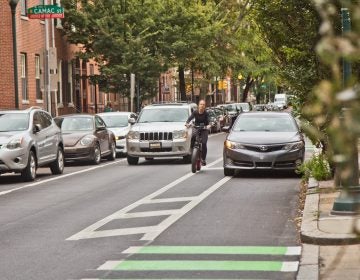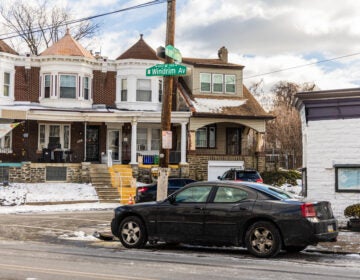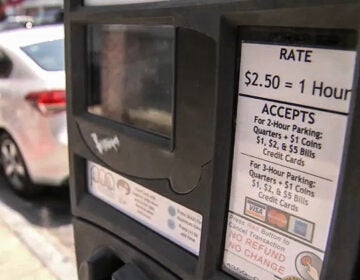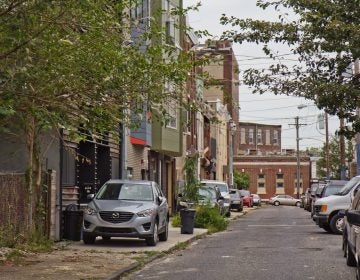Philly to test new tech in bid to stop delivery drivers from parking illegally
The delivery vans blocking Philly streets may soon find themselves under the management of a new tech tool.
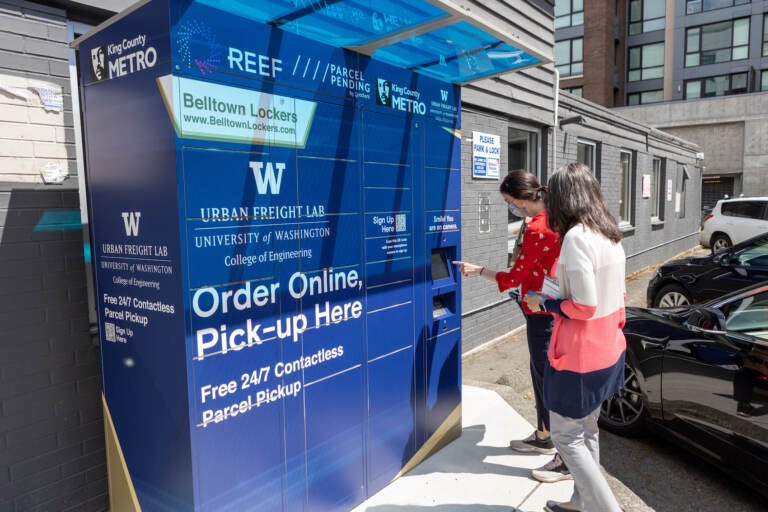
A common-carrier parcel locker. (Courtesy of Urban Freight Lab)
It’s online shopping season, so you might find yourself stuck behind delivery vans blocking the lane more often than usual. But transportation officials envision a better future, where delivery drivers glide smoothly into loading space reserved ahead of time. The city will test the idea in a pilot this spring.
“I think we need a new model of loading zones in the city,” said Christopher Puchalsky, director of policy and strategic initiatives at Philadelphia’s Office of Transportation, Infrastructure, and Sustainability (OTIS). “That’s what the Smart Loading Zone pilot is trying to do.”
The Philadelphia Parking Authority issued more than $2 million worth of tickets to package delivery vehicles in 2020 and is on track to issue roughly the same this year. But e-commerce is still clogging city streets with double-parked trucks and vans.
Philly currently sees more than 600,000 total residential deliveries per year, according to estimates by José Holguín-Veras of Rensselaer Polytechnic Institute’s Center of Excellence for Sustainable Urban Freight Systems. That number is likely to grow, as the World Economic Forum estimates e-commerce demand will bring 36% more delivery vehicles to inner-cities by 2030.
When these vehicles park illegally, they put pedestrians at risk by blocking sight lines, endanger cyclists by obstructing bike lanes and slow down transit. It all comes down to a conflict over precious curb space — which is as useful for the ever-growing online shopping — and delivery-based economy as it is for pedestrians, Uber passengers or even diners eating outdoors.
“It’s definitely an issue that needs to be managed, maybe ‘solved’ is a little too permanent or optimistic, but I think it definitely needs to be managed on an ongoing basis,” Puchalsky said. “The anecdotal evidence is certainly there that there’s a lot more delivery and a lot more illegal parking and loading because of that by delivery vans.”
City transportation officials have set goals to better manage curb space and update fines and fees to reflect today’s parking conflicts. The latest effort is the smart zone Request for Proposals issued last month to test technologies that would allow the city to digitally map the curb space and create a reservation-based loading zone.
Reservable loading zones
Philly’s Smart Loading Zone pilot project will test the use of five types of software applications aimed at making loading activity more efficient and user-friendly, according to the RFP.
The pilot would start in March 2022 and end a year later.
“We’re open to working with companies that can bring some big data approaches to trying to manage this,” Puchalsky said. “So that if you’re a shipper, for example, you could have information on what spots are available and even the possibility of reserving those spots ahead of time in an area, so that you can plan your routes.”
During peak delivery hours, a shipper might pay more to reserve a loading zone, Puchalsky said, but during off-hours, the space might be cheaper.
“It works for everybody, and it’s a way that we can manage the curb space in a more efficient way than just maybe the government, all by itself, setting rates on a one-size-fits-all basis,” Puchalsky said.
Washington, D.C. did a similar pilot project in 2019. It allowed delivery drivers to reserve curb space in nine areas of the city through the third-party website curbFlow. Safety in crosswalks and bike lanes improved during the pilot, and double parking went down. The next year, curbFlow rolled out a system of cameras to let delivery drivers know, in real time, whether a parking space was available. The company’s founder described it as “greasing the wheels of the delivery economy,” helping drivers avoid double parking or endlessly circling a block.
Other cities are trying different ways to balance deliveries with other street uses — but so far, there’s no silver bullet.
“There’s a variety of different approaches the different cities are using,” said Alex Engel, a spokesperson for the National Association of City Transportation Officials (NACTO). “We would say that no city has really perfected this.”
Still, there are a number of strategies NACTO considers “best practices,” which Philly could try.
One strategy is adapting to the growing presence of Amazon vans and Uber drop-offs by setting aside more space for them — expanding loading zones from commercial zones into residential areas, Engel said.
“Sometimes [residential] streets themselves are narrower, so if a truck is double parking, they might be blocking the entire street,” he said. “A lot of cities are starting to pilot or at least look at the idea of loading zones in residential areas to kind of handle this influx that we’ve seen over the last few years.”
On specific streets throughout the five boroughs, New York’s Neighborhood Loading Zone program marks out dedicated curb space for package deliveries by commercial vehicles and taxi and ride-share services. The goal is to prevent double parking on narrow residential streets, tamping down conflicts between trucks and cyclists and improving bus travel times.
Puchalsky said OTIS is interested in expanding loading zones to some areas of residential neighborhoods in Philly, and has even gotten requests for this from communities near Center City.
“An idea that’s been discussed is having the first space or two on every block be loading during the day that then reverts to residential parking at night,” he said. “That way, there’s a regularity that you always know where the spot is going to be.”
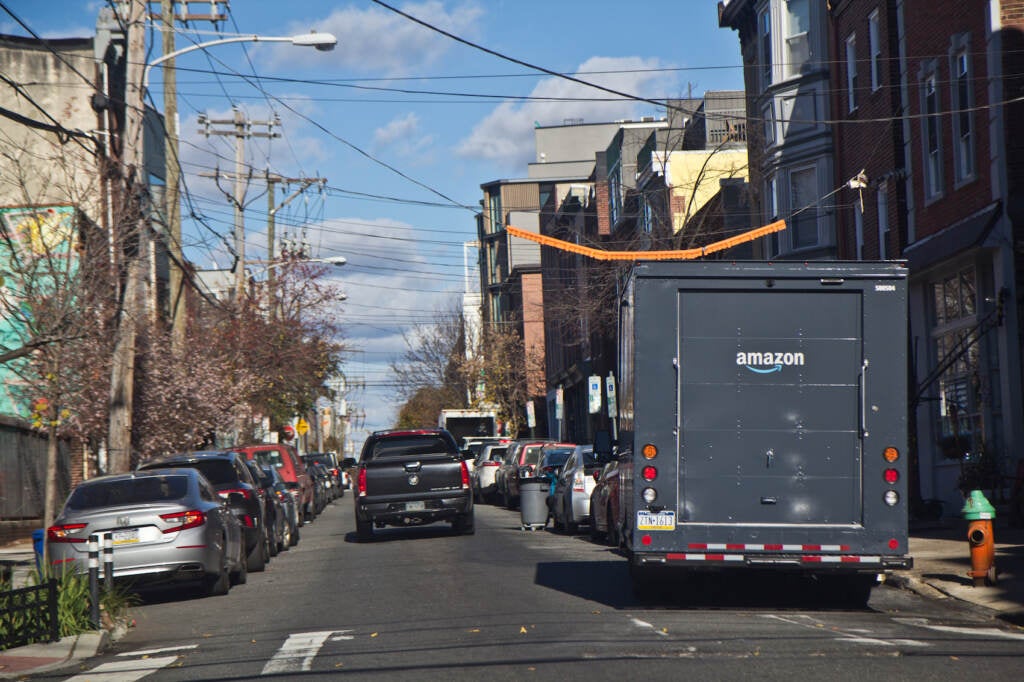
Philly’s Chestnut Street pilot
The city found success reconfiguring loading zones in a 2019 pilot project on a busy section of Chestnut Street.
Around 6,500 people ride transit on Chestnut Street per day, but traffic congestion meant afternoon buses sometimes moved slower than walking speed, according to the city.
The pilot created all-day, 80-foot passenger and freight loading zones on each block, with 20-minute time limits. The rest of the parking lane was devoted to 2-hour meter parking, with bike-share stations on some blocks. Before the pilot, loading was allowed, but only in the mornings.
“The previous regulations were set in the ‘90s, and so we updated it to reflect that there’s both parking needs and loading needs throughout the day,” Puchalsky said.
Transportation officials found during the pilot that illegal parking and loading activity on Chestnut Street went down, and transit travel times improved significantly. The changes are now permanent.
“I think the lessons there of just providing more loading is helpful,” Puchalsky said. “Some of the specific techniques, you know, may or may not be applicable everywhere in the city.”
E-bikes and trikes
Cities like New York City and Seattle have tried using cargo bikes to deliver packages. These bikes — usually motor-assisted, with removable cargo containers — are popular in some European cities and emit less pollution than delivery vans or trucks.
New York City recently passed legislation requiring the city Department of Transportation to develop “micro-distribution centers,” where parcels are transferred from large trucks to smaller vehicles like cargo e-bikes.
In 2017, UPS deployed battery-powered cargo tricycles to make some of its deliveries in downtown Pittsburgh. In Philadelphia, city officials hoped to experiment as well but the pandemic disrupted progress, said Puchalsky.
“We’d be open to exploring that more, working with folks who wanted to do more cargo bike delivery, e-bike delivery services,” he said.
Multi-carrier lockers
Another way to reduce the volume of delivery vehicles on city streets is to have them drop packages off at a locker, rather than customers’ doorsteps.
“Instead of a vehicle making 10 stops in a neighborhood, it makes one stop and delivers 10 parcels to the locker and then the residents pick up from the locker,” said Mike Ruane, manager of the Office of Freight and Aviation Planning at the Delaware Valley Regional Planning Commission.
Customers choose to have their packages delivered to the locker’s address, rather than their home addresses. When packages arrive at the self-serve locker, customers get a notification and an access code, which can unlock compartments of the locker containing their packages. Customers can retrieve their packages on their own timetable over the next few days, since some lockers are open 24/7. The lockers are also a good way to avoid porch pirates, if customers are away from home when packages are delivered.
Amazon already has close to 20 delivery lockers in Philly, but they’re clustered around Center City. A pilot project in Seattle through the University of Washington’s Urban Freight Lab tests an “open-network” locker, which can store deliveries from multiple retailers. It’s part of a three-year project testing the ability of different technology solutions to reduce delivery vehicle dwell time and planet-warming carbon emissions. An initial pilot program eliminated failed first deliveries and reduced delivery time.
A multi-carrier locker may be more convenient for customers than carrier-specific ones, but Ruane said the challenge is funding — since it would need to be paid for by a third party, such as a city government or nonprofit, rather than by the delivery companies.
“I think there’s also potential … partnerships that can be formed so that these could be built or located near transit hubs so that folks that are commuting can access their parcels on their commute,” Ruane said. “It’s not just paying to build them and operate them, but finding space to put them is important as well, that’s centrally located and makes them a part of the community.”
The City of Philadelphia has not been involved in providing multi-carrier lockers, Puchalsky said, but he thinks the carrier-specific package lockers already in the city are a good idea.

Subscribe to PlanPhilly
WHYY is your source for fact-based, in-depth journalism and information. As a nonprofit organization, we rely on financial support from readers like you. Please give today.





